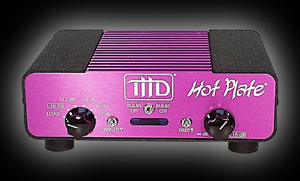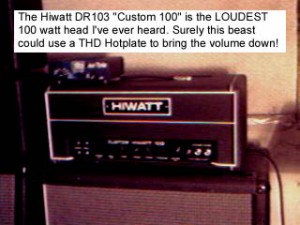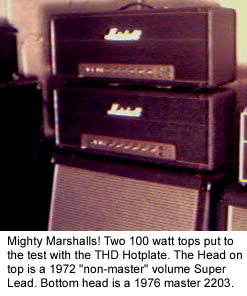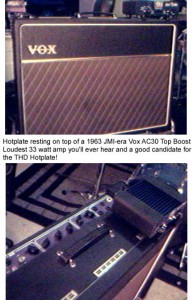It’s not a secret that nothing beats the sound of a great guitar tube amp cranked up. When a tube amp is driven to overdrive, rich and musical even-ordered harmonics flow in abundance and the amplifier seems to take on a new sense of dynamic character that responds better to a player’s touch. It is this feel that gives a tube amp an organic and natural sense, while solid-state amplifiers are considered more sterile in sound because of the lack of this response or harmonics.
The age-old problem has been getting the great tube amp sound at lower and more realistic levels. As the majority of musicians play relatively small clubs and in even smaller practice rooms, only the minority (i.e. those famous guitarists!) get the real opportunity to play these tube amps at the volumes that they sound best. As a result, many of our classic and much beloved Marshall, Fender, and Vox amplifiers are often seen used with distortion and fuzz boxes to compensate. While my personal belief is that these distortion and fuzz boxes are useful in some applications, they are certainly not the best way to achieve great tone when used strictly as the sole source of distortion.
 Power attenuators are devices that are inserted between an amplifier’s speaker output and speaker cabinet that allow you to turn up the amp and then control the overall volume with the attenuator. The concept of how a power attenuator works is simple. The voltage output signal flows out from the amplifier’s speaker output and raises or lowers according to how much volume is used and with how hard it is being driven by the guitar. An attenuator captures a portion of this signal, and rather than let it pass to the speaker, converts this energy into heat. What remains is sent to the speaker cabinet.
Power attenuators are devices that are inserted between an amplifier’s speaker output and speaker cabinet that allow you to turn up the amp and then control the overall volume with the attenuator. The concept of how a power attenuator works is simple. The voltage output signal flows out from the amplifier’s speaker output and raises or lowers according to how much volume is used and with how hard it is being driven by the guitar. An attenuator captures a portion of this signal, and rather than let it pass to the speaker, converts this energy into heat. What remains is sent to the speaker cabinet.
While this sounds like a clever and fairly simple method to solve the problem, it is not so easy to accomplish. Because some of the output signal is captured and dissipated through the attenuators, often attenuators can alter the tone of the final signal and some models in particular can make the attenuated signal sound muddy and indistinct. Early power attenuator designs were also considered dangerous or questionable tools at best, especially as complaints of blown transformers occurred.
New designs, such as the widely-known Marshall PowerBrake and THD Hot Plate are considered safe to use. However, those regular site visitors to LegendaryTones know that I am a Marshall player and in fact I did own and have extensively used the Marshall PowerBrake. While this story is about the THD Hot Plate Power Attenuator, and is not designed to be a comparative review with the Marshall PowerBrake, I need to say that in all applications of use, I found the Marshall PowerBrake a big disappointment. To sum up my thoughts, let’s just say that the PowerBrake is gone and so is my muddied Marshall tone!
The THD Electronics Hot Plate Attenuator on the other hand was quite a surprise and a pleasant one at that. Working with THD for the past several months, they were quite helpful and very accommodating with answering all of my questions about the Hot Plate and I ended up spending more time than usual evaluating it with various amplifiers, if for no other reason than it turned out to be an absolute blast to use!
Features
The Hot Plate’s front control panel has controls for attenuation levels of 0, -4, -8, -12, and –16 dBs as well as a setting for Load that acts as a dummy-reactive load. When set to Load, you can safely use the Hot Plate without attaching speakers to it and instead may use the line out signal on the rear to either drive various effects or run it into another amplifier or mixing console. The Line Out on the rear also has an adjustable volume control.
When setting the attenuation to –16 dB, you can control the overall output with a separate level control on the front panel for even more reduced volume. Two switches on the front panel (Bright and Deep) help tailor the sound to compensate for overly bright or overly bassy tones. Conversely, if there is not enough bass in the tone, using the Deep switch helps fill out the overall bottom end, and if the signal is somewhat dull, using the Bright switch helps liven the tone.
An interesting feature is the built-in noise reduction circuit that works without gating or any other “breathing” issues that can occur with common noise reduction circuits. THD explained it this way. A special bulb that works passively IS the noise reduction system. When lit, signal is going through and the light itself varies with the amount of signal flow. When you stop playing, the light shuts off immediately and in this way reduces the signal as well as the noise. THD explained that this is a well-known, simple but very effective way of creating a noise reduction circuit. Simple perhaps, but certainly elegant as well. A switch on the front allows you to turn this feature on or off.
Another unique feature of the Hot Plate is that it is a frequency-compensated device. This means, according to THD, that the Hot Plate adjusts the overall equalization as the volume is turned down in order to compensate for the human ear’s frequency response. THD’s literature: “Your ear perceives sounds differently at different volumes: the louder the sound, the more sensitive your ears are to the highs and lows. As the volume drops, your ear becomes more sensitive to the mid-range, and less so for the highs and lows. The Hot Plate compensates for this, working like the ‘Loudness’ switch on a hi-fi. The THD Hot Plate is the only attenuator that is frequency compensated.”
When using a powerful amplifier with the Hot Plate (maximum recommended is 185 watts RMS) and driving it hard, a built-in cooling fan on the bottom of the chassis turns on. This is a nice bonus and again is all driven by the power running from the amp’s speaker output. There are no batteries or AC power supplies needed to run the Hot Plate.
The rear of the Hot Plate includes two speaker outputs in addition to the previously mentioned line out and line out level control . A ¼” input jack that accepts the input from the amp’s speaker output itself is also on the rear. A short, but clearly-explained manual is included with all the necessary and appropriate connection information.
Hot Plate units are available in a wide range of impedances for use with different cabinet combinations. The most commonly used Hot Plates will be the 8 or 16 ohm models, but 4 and 2.7 ohm versions are available as well.
Sound
I had a lot of fun with the THD Hot Plate and tested the 16 ohm model with numerous amps including a 1972 Hiwatt DR103 Custom 100 watt, a 1976 Marshall 2203 100 watt master volume head, a 1972 Marshall 100 watt Super Lead, and a 1963 Vox AC30. Here are my thoughts on each of these experiences. I also plan to record sound files with a few of these amps that will be posted soon.
Amp number 1: Hiwatt DR103 Custom 100
If you’ve ever played a Hiwatt or have at least read the feature article here on this beast of an amp, you’ll know that these are among the loudest and best-built 100 watt amps ever produced. In the 1970s, volume seemed to be “cool” and everything was louder including those stadium concerts. This was an interesting time before there was much concern over producing excessive dBs or permanent hearing loss. During that time, anyone could easily blow away a Marshall 100 watt by using a Hiwatt DR103.
 These days, it’s not practical in any application. Modern PA’s are best managed in general with equipment that is miked and they certainly have enough power on hand to supply the entire band’s mix. Certainly with my own Hiwatt in a club environment, I had no choice but to rely on using an overdrive pedal because the volume had to stay below “2” on the amp.
These days, it’s not practical in any application. Modern PA’s are best managed in general with equipment that is miked and they certainly have enough power on hand to supply the entire band’s mix. Certainly with my own Hiwatt in a club environment, I had no choice but to rely on using an overdrive pedal because the volume had to stay below “2” on the amp.
When attaching the Hot Plate, plugging in my Les Paul, cranking the Hiwatt’s master to 8, patching both inputs together and putting both preamps to 10, I got THE tone and was quite frankly amazed. Actually, one area that I needed to experiment with was setting up my tone controls properly on all of the amps and the Hiwatt was no exception. When running so much power through the Hotplate, the bass controls on the amp, which were typically set between 8 and 10, needed to be reduced because of a strange overloaded tone that occurred. Talking with various tone gurus, including Victor Mason at Plexi Palace, I learned that it was “o.k.” to reduce the bass control on an amp. In fact, he explained that if you listen to a guitar tone like Eddie Van Halen’s, it is punchy and smooth due to the mids and highs and there’s very little bass in his overall tone.
I also tended to reduce the presence in all the amplifiers I tested that had a presence control both with and without the Hot Plate as the presence control can really add “shrillness” to the sound especially when an amp is turned up. Presence is not even really a tone control, but a circuit that adds or reduces negative feedback within the circuit itself. The result is of course what amounts to a bright signal and some presence is nice, but it’s best not to overdo it as well.
So with my new knowledge, help and a reduction in bass and presence in my signal, the Hiwatt at low volumes using the Hot Plate could easily accomplish what I call a “power-punchy-rock” tone. Think Pete Townshend of the Who but without having to fear becoming deaf. Dare I say this, but by clicking on the deep switch, I felt I had a much smoother and balanced tone than Pete’s and of course it was very manageable. With the Les Paul at hand, the sound was very aggressive and with the high output pickups helping drive the signal as well, the tones that came out were very driving like a Marshall, but with a hint more punch in the signal, hence my term, “power-punchy-rock.”
In the end, the Hiwatt DR103 and the Hotplate are a perfect match if you want to get full-blown output tube distortion from your amp without making your ears bleed!
Amp number 2: 1976 Marshall MK 2 100 watt master volume
This is the first-year Marshall 100 watt master volume amp that Marshall produced to address players’ needs for getting distortion at low volumes. The only problem is that the distortion produced is strictly preamp-tube distortion at lower volumes so it’s an entirely different sound. That said, many (myself included) do love this particular tone as it is certainly aggressive and still very “modern” sounding.
What sounds even better however is when you crank the amp up. Then you get a nice mix of power tube distortion that is much more sensitive and helps provide extra fat bottom end. Of course in this case you’re still in the same boat of having to “crank it” to get that particular sound.
I’ve gotta tell you, the Hot Plate did a hell of a job taking on this Marshall!
In a word, I can sum up the results of the Hot Plate with the Marshall by saying this: Amazing! It didn’t matter if I reduced the attenuation a little bit or down to 16 dBs. The tone out of this amp kicked with the Master Volume set on 8. Very full, not overly bright and the deep switch helped out again to bring out some of the bass. Smooth rock tone with enough sustain on tap to get a great lead tone without the need for any pedals at my feet.
Amp number 3: 1972 Marshall Super Lead 100
 Like the Hiwatt, the Super Lead 100 from Marshall is another famously loud rock and roll amplifier and unlike my ’76, the ’72 has no preamp gain controls. The Super Lead is the famous “4-input” style Marshall amp and one we also wrote a feature about here at LegendaryTones.
Like the Hiwatt, the Super Lead 100 from Marshall is another famously loud rock and roll amplifier and unlike my ’76, the ’72 has no preamp gain controls. The Super Lead is the famous “4-input” style Marshall amp and one we also wrote a feature about here at LegendaryTones.
Setting my tone controls in general at a midway-up fashion, both volumes set to 8 and linking the bright and normal channels together, I had an immediate high-gain sound that was reminiscent of the best of the ‘80s-era hard rock guitar tones. The 1972 model Super Lead had more gain on tap than the early plexis and this was apparent when pumping the signal through a basketweave G12H30-equipped Marshall cab. This tone was achieved with a Les Paul. When using a stock Fender Stratocaster, I could get some nice bluesy dirt and grind out of the Marshall that warmed up nicely using the neck pickup. Nice sustain of course with those saturating EL34 tubes running.
The beauty of using the Hot Plate in this type of setup was the amp’s ability to really respond to my playing dynamics and getting that balance of clean and breakup of the signal through the tube’s natural distortion characteristics: all at low volumes. Hitting the deep switch also really brought out some nice bottom out of the Stratocaster as well.
The test of the Super Lead through the Hotplate wouldn’t be complete without trying out a Van Halen-style rig by using a dummy-load type of setup. I even used a Variac for this experiment that really does “brown” up the signal as they’d say by dropping the line voltage from 120 to 90 volts. Because I was running lower voltage, I felt more comfortable setting the volumes on the Marshall to 10 and therefore not straining the output transformer in the process. I set the Hot Plate to “load”, ran the direct out to an old MXR Phase 90 and an old analog delay for fun and then put the final signal to my Hiwatt set clean running two Marshall cabinets.
First result: it sounded terrible! Why? Well, I learned (and this is also documented in the Hot Plate User Guide) that in some cases, a ground loop can occur and this can be resolved by lifting one end of the ground off of the line out cable (which is a standard guitar cord, not a speaker cable in this instance). When there’s a ground-loop going on, the signal sounds like more like a broken transistor amp. However, this was easily taken care of by disconnecting the cable’s ground. After doing this, the system worked fine using the Marshall as an overall preamp for the entire system.
What worked even better however, was to mix this “wet” signal (called that because of the effects running through the chain) with a dry cab as well. In this fashion, I set the control from Load to -16 dB and mixed in the result. Very nice and instant early EVH tones on tap. What a sound when I tuned my guitar to dropped D and played through the “Unchained” intro!
Amp number 4: 1963 Vox AC30 top boost
The early JMI Vox AC30’s are among my personal favorite amplifiers for their great diversity. I love their sparkling clean tones and when cranking them up through their brilliant channel with top boost, they get a beautifully smooth and very musical overdrive.
I run my Vox in an interesting fashion. Using the Framptone Amp Switcher, which I recently reviewed, I run the output channel A into the normal or vibrato channel of the Vox. The output channel B of the amp switcher goes into an e.q. box to add a little boost when desired and then into the top-boosted brilliant channel of the Vox.
Each of the Vox’ channels have independent volume controls and the top boosted brilliant channel features independent bass and treble controls. The volume of the brilliant channel goes to 8 and the normal or vibrato channel will be set between four and five for a clean tone.
I use my Stratocasters strictly with the Vox as I don’t particularly care for it so much with my Les Paul. Using the Hot Plate, to attenuate what would be a very loud 33 watts, the sound was transparent and true to what a Vox should be like. With the amp switcher, I gain the benefit of making this classic amp a true modern channel switching tone king. With the Hot Plate the levels are controllable and you get the sweet and very responsive overdrive that Vox was made for.
 The Normal channel easily does the Beatles tone, but the brilliant channel with top boost and my e.q. to help drive it does the smooth overdrive that is very reminiscent of Brian May’s great and very unique tone. It’s obviously not a spot on replica of the tone, as Brian May interestingly enough used normal, not top boosted models as well as incorporating various custom items from his guitar to his special treble booster box – but all in all, the tone represents the beauty that is Vox in a very listenable and controlled environment. I couldn’t ask for anything more.
The Normal channel easily does the Beatles tone, but the brilliant channel with top boost and my e.q. to help drive it does the smooth overdrive that is very reminiscent of Brian May’s great and very unique tone. It’s obviously not a spot on replica of the tone, as Brian May interestingly enough used normal, not top boosted models as well as incorporating various custom items from his guitar to his special treble booster box – but all in all, the tone represents the beauty that is Vox in a very listenable and controlled environment. I couldn’t ask for anything more.
Overall Conclusion
The Hot Plate is not a “perfect” item, but it is close and there is only really one area that I could gripe about. If you have two amps and one is an 8 ohm and the other a 16, it is recommended that you get separate Hot Plates. It would be nice to have an “all in one” type of unit available. When discussing this with THD, in fact you can use different impedance models, but the frequency compensation e.q.’ing is not as effective when a perfect match isn’t made. You’ll want to discuss this with THD or a THD dealer if you want more info about this. In my setup, it doesn’t matter as 16 ohm loads are all that are used.
Also some can criticize attenuators like the Hot Plate and state that you’re still “missing” something in the tone because speaker breakup often helps the signal out and is a great tone shaper too. That is true to an extent, but that is not the fault of the Hot Plate and I question how much speaker distortion I’d want anyway. Really, when you’re distorting the speakers, it basically means you’re moving the speaker’s voice coils too far, they’re then becoming really hot and of course exceeding their specs. Unlike tubes – that do great exceeding their specs but are also expected to be replaced at normal intervals, destroying a speaker in this overloading high-volume fashion isn’t something I can personally afford to do. If you need to run your amps to the point where your speakers are distorting and that’s your tone, go do it.
In the end though, the Hot Plate is the first real “must have” item if you are interested at all in exploring the beauty of power tube distortion available within your tube guitar amplifier. Today’s modern high-gain amps are fairly well-tuned in that their preamp stages are dialed in and sound reasonable. However, added stages of preamp overdrive running on top of each other doesn’t bring a sense of dynamics whatsoever. In addition, the musical harmonics and tones that come from a set of power tubes cannot be matched or compared when they are driven hard. This is what the “new” amps are missing, whether it’s a Mesa/Boogie or a Marshall, they just don’t feel very “tube-like” if you abuse their preamp-gain controls which is very easy to do and is quite commonly done by many new bands. To each his/her own, but if you’ve never had the opportunity to experience output tube distortion in your music, it’s worth experiencing and the Hot Plate helps make it happen at listenable, not deafening levels.
In my mind, one of the best half-stack tone deals on the market today for rock players as of this writing in mid 2001, is a mid ‘70s Master Volume Marshall MKII JMP model. Used without a Hot Plate, you’ll enjoy its driving tones that also really project well in band playing situations. Use it in conjunction with a Hot Plate and you’ll fall in love with the amp all over again for its “new” sounds.
While it wasn’t THD President Andy Marshall’s intention to do so, an old Marshall and a Hot Plate are really “made for each other.” In addition, the Hiwatt and Vox sounded fantastic with the Hot Plate. I can honestly conclude that the Hot Plate is indeed the most significant piece of gear I’ve encountered for use with a tube amplifier, both old and new. It is clearly for this reason, that LegendaryTones proudly awards the THD Hot Plate with a perfect 10 score. For more information about THD’s products visit, www.thdeelectronics.com.